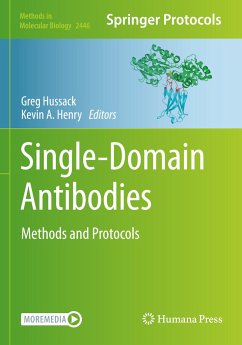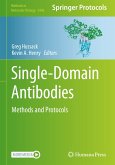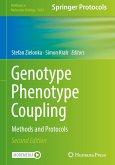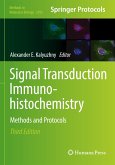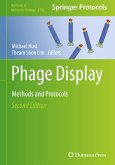Single-Domain Antibodies
Methods and Protocols
Herausgegeben:Hussack, Greg; Henry, Kevin A.
Single-Domain Antibodies
Methods and Protocols
Herausgegeben:Hussack, Greg; Henry, Kevin A.
- Broschiertes Buch
- Merkliste
- Auf die Merkliste
- Bewerten Bewerten
- Teilen
- Produkt teilen
- Produkterinnerung
- Produkterinnerung
This volume covers current and emerging techniques for studying single-domain antibodies (sdAbs). Chapters guide readers through the biology and immunology of sdAbs in camelids and sharks, isolation of sdAbs, protein engineering approaches to optimize the solubility, stability, valency and antigen binding affinity of sdAbs, and specialized applications of sdAbs. Written in the format of the highly successful Methods in Molecular Biology series, each chapter includes an introduction to the topic, lists necessary materials and reagents, includes tips on troubleshooting and known pitfalls, and…mehr
Andere Kunden interessierten sich auch für
![Single-Domain Antibodies Single-Domain Antibodies]() Single-Domain Antibodies208,99 €
Single-Domain Antibodies208,99 €![Genotype Phenotype Coupling Genotype Phenotype Coupling]() Genotype Phenotype Coupling171,99 €
Genotype Phenotype Coupling171,99 €![Signal Transduction Immunohistochemistry Signal Transduction Immunohistochemistry]() Signal Transduction Immunohistochemistry116,99 €
Signal Transduction Immunohistochemistry116,99 €![Base Editors Base Editors]() Base Editors97,99 €
Base Editors97,99 €![Phage Display Phage Display]() Phage Display208,99 €
Phage Display208,99 €![Base Editors Base Editors]() Base Editors149,99 €
Base Editors149,99 €![Structure Of The Nucleus Structure Of The Nucleus]() M. A. PrestonStructure Of The Nucleus182,99 €
M. A. PrestonStructure Of The Nucleus182,99 €-
-
-
This volume covers current and emerging techniques for studying single-domain antibodies (sdAbs). Chapters guide readers through the biology and immunology of sdAbs in camelids and sharks, isolation of sdAbs, protein engineering approaches to optimize the solubility, stability, valency and antigen binding affinity of sdAbs, and specialized applications of sdAbs. Written in the format of the highly successful Methods in Molecular Biology series, each chapter includes an introduction to the topic, lists necessary materials and reagents, includes tips on troubleshooting and known pitfalls, and step-by-step, readily reproducible protocols.
Authoritative and cutting-edge, Single-Domain Antibodies: Methods and Protocols aims to be a useful, practical guide to help researchers further their studies in this field.
Authoritative and cutting-edge, Single-Domain Antibodies: Methods and Protocols aims to be a useful, practical guide to help researchers further their studies in this field.
Produktdetails
- Produktdetails
- Methods in Molecular Biology 2446
- Verlag: Humana / Springer US / Springer, Berlin
- Artikelnr. des Verlages: 978-1-0716-2077-9
- 1st edition 2022
- Seitenzahl: 628
- Erscheinungstermin: 15. Februar 2022
- Englisch
- Abmessung: 254mm x 178mm x 34mm
- Gewicht: 1163g
- ISBN-13: 9781071620779
- ISBN-10: 1071620770
- Artikelnr.: 67308151
- Herstellerkennzeichnung
- Springer-Verlag GmbH
- Tiergartenstr. 17
- 69121 Heidelberg
- ProductSafety@springernature.com
- Methods in Molecular Biology 2446
- Verlag: Humana / Springer US / Springer, Berlin
- Artikelnr. des Verlages: 978-1-0716-2077-9
- 1st edition 2022
- Seitenzahl: 628
- Erscheinungstermin: 15. Februar 2022
- Englisch
- Abmessung: 254mm x 178mm x 34mm
- Gewicht: 1163g
- ISBN-13: 9781071620779
- ISBN-10: 1071620770
- Artikelnr.: 67308151
- Herstellerkennzeichnung
- Springer-Verlag GmbH
- Tiergartenstr. 17
- 69121 Heidelberg
- ProductSafety@springernature.com
Nanobodies: From Serendipitous Discovery of Heavy Chain-Only Antibodies in Camelids to a Wide Range of Useful Applications.- Overview, Generation, and Significance of Variable New Antigen Receptors (VNARs) as a Platform for Drug and Diagnostic Development.- Llama DNA Immunization and Isolation of Functional Single-Domain Antibody Binders.- Preparation of Immune and Synthetic VNAR Libraries as Sources of High-Affinity Binders.- Isolation of Single-Domain Antibodies to Transmembrane Proteins Using Magnetized Yeast Cell Targets.- A Transgenic Heavy Chain IgG Mouse Platform as a Source of High Affinity Fully Human Single-Domain Antibodies for Therapeutic Applications.- Cytoplasmic Production of Nanobodies and Nanobody-Based Reagents by Co-Expression of Sulfhydryl Oxidase and DsbC Isomerase.- Small Scale Secretory VHH Expression in Saccharomyces cerevisiae.- Production of Single-Domain Antibodies in Pichia pastoris.- Production of Designer VHH-Based Antibodies in Plant.- Assessing the Aggregation Propensity of Single-Domain Antibodies Upon Heat-Denaturation Employing the DeltaTm Shift.- Facile Affinity Maturation of Single-Domain Antibodies Using Next-Generation DNA Sequencing.- Engineering pH-Sensitive Single-Domain Antibodies.- Humanization of Camelid Single-Domain Antibodies.- Creation of Multimeric Single-Domain Antibodies Using Bacterial Superglues.- Introducing Cysteines into Nanobodies for Site-Specific Labelling.- Affinity-Guided Site Selective Labelling of Nanobodies With Aldehyde Handles.- Cytoplasmic Expression of Nanobodies with Formylglycine Generating Enzyme Tag and Conversion to a Bio-Orthogonal Aldehyde Group.- Site-Specific Fluorescent Labelling, Single-Step Immunocytochemistry, and Delivery of Nanobodies into Living Cells.- Design and Validation of Site-Specifically Labelled Single-Domain Antibody-Based Tracers forIn Vivo Fluorescence Imaging and Image-Guided Surgery..- Design and Preparation of Photobodies: Light-Activated Single-Domain Antibody Fragments.- Visualizing Filoviral Nucleoproteins Using Nanobodies Fused to the Ascorbate Peroxidase Derivatives APEX2 and dEAPX.- Development of Glypican-2 Targeting Single-Domain Antibody CAR T Cells for Neuroblastoma.- Single-Domain Antibodies for Intracellular Toxin Neutralization.- Generation of Single-Domain Antibody-Based Recombinant Immunotoxins.- X-Ray Crystal Structure Analysis of VHH-Protein Antigen Complexes.- Functionalization of Magnetic Beads with Biotinylated Nanobodies for MALDI-TOF/MS-Based Quantitation of Small Analytes.- Nanobody-Based Assays for the Detection of Environmental and Agricultural Contaminants.- Peptide Tag-Specific Nanobodies for Studying Proteins in Live Cells.- Nanobody-Based GFP Traps to Study Protein Localization and Function in Developmental Biology.- Optogenetic Activation of Intracellular Nanobodies.
Nanobodies: From Serendipitous Discovery of Heavy Chain-Only Antibodies in Camelids to a Wide Range of Useful Applications.- Overview, Generation, and Significance of Variable New Antigen Receptors (VNARs) as a Platform for Drug and Diagnostic Development.- Llama DNA Immunization and Isolation of Functional Single-Domain Antibody Binders.- Preparation of Immune and Synthetic VNAR Libraries as Sources of High-Affinity Binders.- Isolation of Single-Domain Antibodies to Transmembrane Proteins Using Magnetized Yeast Cell Targets.- A Transgenic Heavy Chain IgG Mouse Platform as a Source of High Affinity Fully Human Single-Domain Antibodies for Therapeutic Applications.- Cytoplasmic Production of Nanobodies and Nanobody-Based Reagents by Co-Expression of Sulfhydryl Oxidase and DsbC Isomerase.- Small Scale Secretory VHH Expression in Saccharomyces cerevisiae.- Production of Single-Domain Antibodies in Pichia pastoris.- Production of Designer VHH-Based Antibodies in Plant.- Assessing the Aggregation Propensity of Single-Domain Antibodies Upon Heat-Denaturation Employing the DeltaTm Shift.- Facile Affinity Maturation of Single-Domain Antibodies Using Next-Generation DNA Sequencing.- Engineering pH-Sensitive Single-Domain Antibodies.- Humanization of Camelid Single-Domain Antibodies.- Creation of Multimeric Single-Domain Antibodies Using Bacterial Superglues.- Introducing Cysteines into Nanobodies for Site-Specific Labelling.- Affinity-Guided Site Selective Labelling of Nanobodies With Aldehyde Handles.- Cytoplasmic Expression of Nanobodies with Formylglycine Generating Enzyme Tag and Conversion to a Bio-Orthogonal Aldehyde Group.- Site-Specific Fluorescent Labelling, Single-Step Immunocytochemistry, and Delivery of Nanobodies into Living Cells.- Design and Validation of Site-Specifically Labelled Single-Domain Antibody-Based Tracers forIn Vivo Fluorescence Imaging and Image-Guided Surgery..- Design and Preparation of Photobodies: Light-Activated Single-Domain Antibody Fragments.- Visualizing Filoviral Nucleoproteins Using Nanobodies Fused to the Ascorbate Peroxidase Derivatives APEX2 and dEAPX.- Development of Glypican-2 Targeting Single-Domain Antibody CAR T Cells for Neuroblastoma.- Single-Domain Antibodies for Intracellular Toxin Neutralization.- Generation of Single-Domain Antibody-Based Recombinant Immunotoxins.- X-Ray Crystal Structure Analysis of VHH-Protein Antigen Complexes.- Functionalization of Magnetic Beads with Biotinylated Nanobodies for MALDI-TOF/MS-Based Quantitation of Small Analytes.- Nanobody-Based Assays for the Detection of Environmental and Agricultural Contaminants.- Peptide Tag-Specific Nanobodies for Studying Proteins in Live Cells.- Nanobody-Based GFP Traps to Study Protein Localization and Function in Developmental Biology.- Optogenetic Activation of Intracellular Nanobodies.

